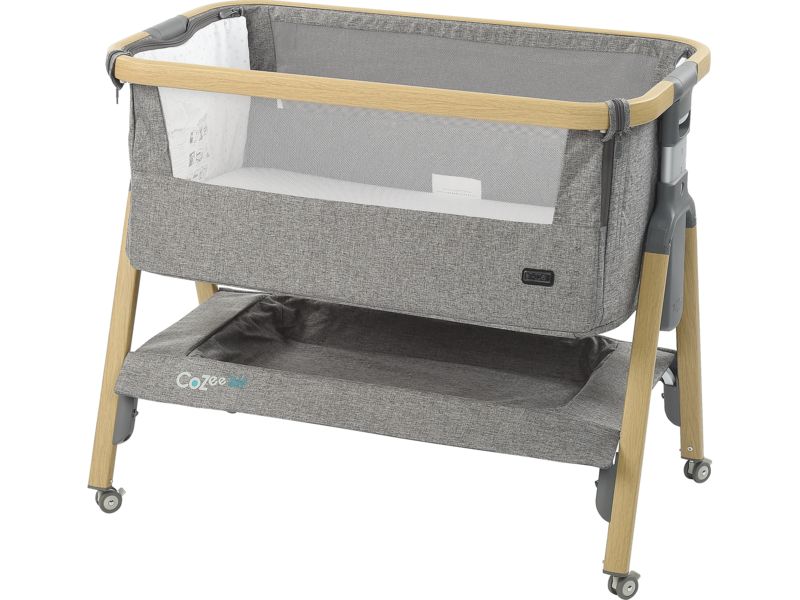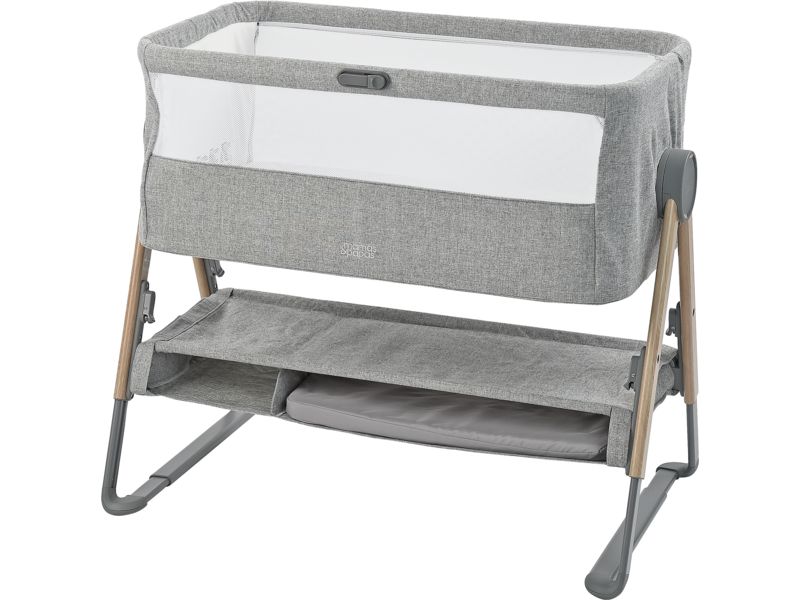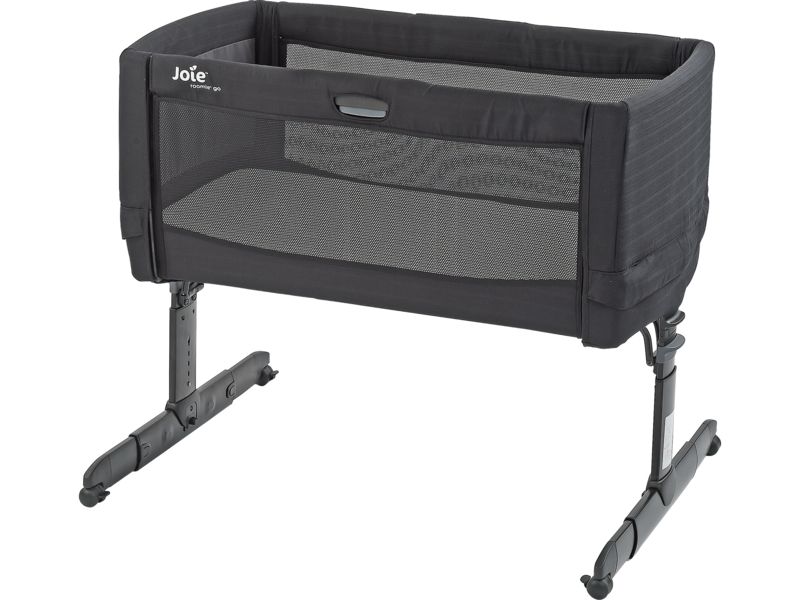By clicking a retailer link you consent to third-party cookies that track your onward journey. If you make a purchase, Which? will receive an affiliate commission, which supports our mission to be the UK's consumer champion.
How we test bedside cribs

In this article
- What are Which? Best Buys, Don’t Buys and Great Value bedside cribs?
- Bedside cribs safety standards
- How easy is it to assemble and disassemble?
- How good is its build quality?
- How easy is it to remove your child from the crib and place them back in?
- Is the cot mattress firm enough?
- How moisture resistant is the mattress?
- Does the mattress have good airflow?
During the newborn months, your baby will be sleeping a lot. This means your bedside crib is going to be one of the most-used items you're buying for your newborn.
We assess the features that we feel will be the most practical, for example an easy to use drop side for quick access to your baby during the night, or whether there’s removable and washable covers and, if so, how well they fare during our wash tests.
We look at how easy it is to assemble and disassemble, and whether it comes supplied with a travel bag because portability might be important to you if you're visiting friends and family. For more helpful advice on what to look for, take a look at our best bedside cribs guide.
Our tests are informed by our years of testing experience. We buy all the bedside cribs ourselves, so you can be sure that the reviews you read are entirely independent and unbiased.
Find out which bedside cribs keep your baby supported in our bedside crib reviews
What are Which? Best Buys, Don’t Buys and Great Value bedside cribs?

Best Buys
The bedside cribs that impress us the most in our tests are made Best Buys. A bedside crib needs to score 70% or more in our tests to become a Best Buy, but you should still read our reviews to check for any factors that might impact your buying decision. Take a look at our Best Buy bedside crib reviews.
Don't Buys
Bedside cribs that receive a poor score of 45% or lower are Don't Buys and should be avoided - these are likely to have safety issues that could be dangerous for your baby or toddler.
Our bedside crib reviews are for Which? members, but any mattresses labelled 0% Don't Buys are given a safety alert that's free for anyone to read, as we believe it's our public duty to inform all parents about any serious hazards or risks that our tests have uncovered. Check to see which are Don't Buy bedside cribs.
Great Value bedside cribs
Great Value models do pretty well in our tests – they need to score at least 65% and be at least 20% cheaper than the average cost of the other bedside cribs in our tests. These are ideal if you're looking for a bargain. Some Great Value bedside cribs also score well enough to be a Best Buy. See our Great Value bedside crib reviews.
Bedside cribs safety standards
Our safety tests replicate those in the current cribs safety standard, which is BS EN 1130:2019. We also test the cot mattresses to the current cot mattress safety standard, which is BS EN 16890:2017 + A1:2021.
Both standards are voluntary, which means it's not a legal requirement to follow them. However, manufacturers are strongly encouraged to meet these standards to minimise risks and hazards for babies.
The standard tests include checking for choking and swallowing hazards, such as loose zip pulls, as well as entrapment and suffocation risks.
How easy is it to assemble and disassemble?
Straight out of the box, we want to know how easy it is to assemble. Can the crib be put together by one person, or is it a two-person job?
Let’s face it, you'll probably be tired of building baby furniture by this point, so the easier the better. We also want to ensure that it isn’t possible to assemble the crib incorrectly and that the instructions and parts are clearly marked to aid correct assembly of the bedside crib.
How good is its build quality?
We want to know whether all of the component parts and the assembled crib itself feel well constructed and sturdy. A wobbly or flimsy-feeling crib won’t fill you with confidence.
How easy is it to remove your child from the crib and place them back in?
Often you will be doing this in the middle of the night, so having easy access to your baby and being able to quietly place them back in will be imperative.
We assess how easy and quiet it is to raise and lower the drop side so you won’t disturb your baby once you’ve finally got them back to sleep.
Is the cot mattress firm enough?
Before we start any of our other tests on the mattress, we check to see how firm it is. This means we can tell you how firm the mattress is when it's new, and how this compares with other mattresses.
One of our tests investigates whether a mattress is firm enough to ensure your baby is still able to breathe when they roll over onto their face while sleeping.
If the top layers of the mattress are too soft and your baby accidentally rolls on to their front, their face could sink into the mattress and this poses a suffocation risk.
It’s a concern with babies aged between four and 12 weeks, when they're typically able to roll over from their back to their front.
Rolling from front to back requires more strength, and in some cases a baby may not master this skill until they reach around six months old.
Ensure a safe environment for your baby with our guide to cot mattress and baby bedding safety
How moisture resistant is the mattress?

The truth is that the mattress is going to be subjected to a lot of liquids. Babies get sick, their nappies leak, and numerous spills are inevitable.
Not only is it important that your baby doesn’t sleep on a damp mattress, but also that the mattress stays clean of any bad bacteria. But if liquids are settling deep into your baby’s bedside crib mattress, it's going to be difficult to tell if it's still hygienic.
We test each mattress within the bedside crib to see how resistant it is to moisture permeating its inner layers. We've found that some are very good at preventing this, while others allow liquids to pass through easily.
Does the mattress have good airflow?
We use special equipment to check the airflow through the mattress.
This is to assess how breathable it is, as it’s important for fresh air to circulate around your baby’s face.
It’s also to see whether the mattress draws away body warmth effectively so your baby doesn’t overheat.
How easy will it be to clean?

You will probably need to start cleaning the mattress right from the start.
If it comes with a removable cover, we'll check how easy this is to get on and off. You don’t want to be battling with an awkward cover when trying to clean a soiled mattress in the middle of the night.
We also assess how the mattress cover fares after several washes, and check to see if there is any shrinkage or bobbling to the fabric.
If a cover shrinks, then it could potentially compress the mattress. The smaller dimensions might mean that the mattress no longer sits flush within the cot bed, and if there’s a gap of a few centimetres, there’s a risk that a baby can trap a limb and become stuck.
If your baby becomes trapped and is positioned face down, this could be a serious suffocation risk.
Should I buy it?
Each of the above tests counts toward a total test score. This score is the overall percentage you will spot next to each of our bedside crib reviews. To become a Which? Best Buy, a bedside crib needs to score at least 70%.
Not every aspect of the bedside crib carries an equal weighting in the total test score. We've considered which aspects will be the most important, and have broken down the score as follows. The cot mattress tests account for 50% of the score and the bedside crib tests account for 50%.
Our reviews completely ignore the price. Check out our bedside crib reviews to see which ones we've tested.
Cot mattress
- 60% performance (permeability and air resistance)
- 30% safety (any entrapment risks, or suffocation and choking hazards)
- 10% convenience (removing and cleaning the cover, cover shrinkage and refitting issues).
Bedside crib
- 28% ease of placing/removing child into/from the crib
- 28% ease of adjusting the crib
- 22% assembly and disassembly
- 11% build quality
- 7% portability
- 4% instructions.


